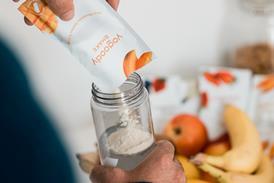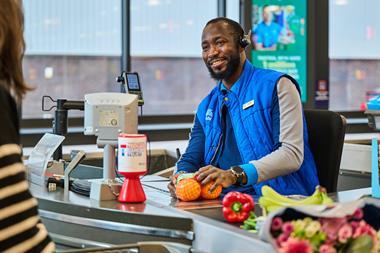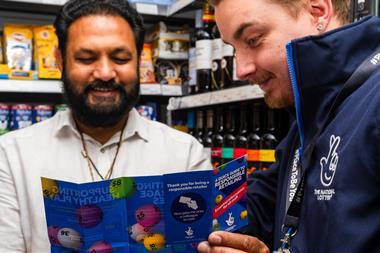As the financial markets crash around us, shoppers are worrying about their jobs, their bills and whether their savings are safe in the bank. And latest evidence suggests even the weekly food bill is being closely examined.
‘Middle-market’ grocers Marks & Spencer, Waitrose and Sainsbury’s are seen as the most vulnerable to shoppers’ cutbacks. In contrast, discount stores Aldi and Lidl are being touted as the new market heroes for tough economic times.
But with Sainsbury’s reporting better than expected quarterly like-for-like sales growth of 4.3% (excluding fuel), are such claims valid? Possibly. M&S last week revealed a 5.9% drop in year-for-year like-for-like food sales in the three months to the end of September, and Waitrose reported a 0.7% drop in sales last week. Although this suggests Sainsbury’s is holding its own, figures from TNS show that in the 12 weeks to 6 September Sainsbury’s sales grew by 5.6% – a lower rate than Asda and Morrisons (both close to 9%) and Tesco at 6.7%. Aldi’s and Lidl’s sales growth, meanwhile, was well into double digits.
According to its own switching data, TNS says Sainsbury’s is losing share to Tesco and Morrisons as well as Aldi and Lidl.
“Price has gone up the agenda and the reaction is an obvious one,” says TNS director of research Ed Garner. If the TNS evidence is anything to go by, as the downturn takes hold Sainsbury’s will come under increasing pressure. Shoppers who are cautiously reining in their spending may soon be forced to make serious cutbacks and the discounters are more than ready to find new converts in that environment.
What’s more, figures released by CACI earlier this week indicated that there are 1,000 locations in the UK that could support a discounter. The bad news for Sainsbury’s is that many of those areas are in its south-east heartland. The study says that £11bn of Sainsbury’s £17.8bn revenue comes from areas where it could soon be in direct competition with Aldi and Lidl.
Secondary high streets
Experts say discounters are prepared to fuel their expansion by taking a wide variety of stores, squeezing themselves on to secondary high streets and into units made available as retail chains succumb to the consumer downturn.
“Sainsbury’s, for the first time, is going to see vast chunks of its catchment being hit by the value players,” says Paul Langston, associate director for location strategy at CACI. These discounters, who have benefited from a surge in media interest over the past year, are increasingly targeting middle-class customers. Figures from a recent Harris Interactive poll indicate that this strategy is working – 29% of shoppers in social grade C1 are choosing to visit discounters more frequently, exactly the same figure as the increase in shoppers overall.
Langston says wealthier shoppers will use Aldi and Lidl if they are within the catchment, helping to significantly increase the discounters’ market share.
Muted response
While Tesco has responded to the threat by introducing ‘discounter’ ranges and spending heavily on recasting itself as Britain’s Biggest Discounter, Sainsbury’s response has been more muted. It has raised the profile of its Basics range, which has expanded 30% over the past year to 550 lines, and encouraged shoppers to ‘switch and save’ from premium brands and to feed the family for a fiver.
Sainsbury’s prices on known value items such as Nescafé and Corn Flakes relative to Tesco and the rest of the market have also dropped in the past year. Sainsbury’s still needs to be more aggressive on Basics, however, says Oriel Securities analyst Jonathan Pritchard.
“It should get that on to the TV a bit more as well as putting more promotions in store so people feel they have that option,” he says. But without taking a hatchet to margins or damaging its key brand value of quality, Sainsbury’s has limited options to fight back on price against the superior buying power of Tesco or the value position of Asda and Morrisons.
Focusing solely on price has been a disaster for Sainsbury’s before, notably in its Value to Shout About campaign fronted by comedian John Cleese in 1999. The campaign, which was hated by shoppers who were shocked by Sainsbury’s sudden focus on cheap prices rather than quality, led to falling average spend as shoppers cherrypicked the best bargains.
Sainsbury’s claims its customers have stayed loyal, with transaction numbers up. It says the biggest change in behaviour has been a move from brands to own label, not a switch to other retailers. As shoppers have moved away from ready meals to making food from scratch, it claims it has benefited from a focus on quality.
A company spokeswoman gives short shrift to suggestions it is in the same boat as M&S. “We don’t subscribe to that because we have spent four years making sure we have got broad appeal.” Sainsbury’s is also benefiting from shoppers trading down from M&S and Waitrose, claims the spokeswoman. Garner argues that M&S is far more vulnerable to the downturn than Sainsbury’s because it has positioned itself as a “repertoire” outlet, which shoppers visit in addition to their main store. In tough times, shoppers are cutting back on those “little extras”. “The pressure on Sainsbury’s is not the same as on Marks & Spencer’s food. It is seeing lower growth, not negative numbers,” he adds. As far as the threat from the discounters is concerned, TNS says switching data shows that, while all the supermarkets are losing sales to the discounters, Tesco is suffering the most, which helps explain its new “discounter” image. That said, the switch to the discounters has been somewhat overplayed, believes Garner.
Market share
If the market share of Kwik Save and Iceland are included, the discounters’ total share of the market has actually fallen 0.1 percentage points in the past five years, according to TNS data. The figures suggest Lidl and Aldi have chiefly, certainly in the longer term, been benefiting from taking on Kwik Save’s stores and customers, rather than a surge in the number of shoppers visiting each outlet.
That’s not to say that, as Lidl and Aldi gradually open more stores and capitalise on their recent high profile, they won’t have greater impact over time. Research from Him! predicts the discounters’ share of the overall grocery market will rise by 1.7% to 6.7% by 2009 as shoppers tighten their belts. Yet, as Andrew Kasoulis, an analyst at Credit Suisse, points out, Sainsbury’s biggest headache may not be lost sales. With value so high on shoppers’ agenda, it is going to have to keep a lid on prices amid continuing cost pressures.
“This may not be about holding on to sales, but holding on to profits,” Kasoulis says.
But with Sainsbury’s reporting better than expected quarterly like-for-like sales growth of 4.3% (excluding fuel), are such claims valid? Possibly. M&S last week revealed a 5.9% drop in year-for-year like-for-like food sales in the three months to the end of September, and Waitrose reported a 0.7% drop in sales last week. Although this suggests Sainsbury’s is holding its own, figures from TNS show that in the 12 weeks to 6 September Sainsbury’s sales grew by 5.6% – a lower rate than Asda and Morrisons (both close to 9%) and Tesco at 6.7%. Aldi’s and Lidl’s sales growth, meanwhile, was well into double digits.
According to its own switching data, TNS says Sainsbury’s is losing share to Tesco and Morrisons as well as Aldi and Lidl.
“Price has gone up the agenda and the reaction is an obvious one,” says TNS director of research Ed Garner. If the TNS evidence is anything to go by, as the downturn takes hold Sainsbury’s will come under increasing pressure. Shoppers who are cautiously reining in their spending may soon be forced to make serious cutbacks and the discounters are more than ready to find new converts in that environment.
What’s more, figures released by CACI earlier this week indicated that there are 1,000 locations in the UK that could support a discounter. The bad news for Sainsbury’s is that many of those areas are in its south-east heartland. The study says that £11bn of Sainsbury’s £17.8bn revenue comes from areas where it could soon be in direct competition with Aldi and Lidl.
Secondary high streets
Experts say discounters are prepared to fuel their expansion by taking a wide variety of stores, squeezing themselves on to secondary high streets and into units made available as retail chains succumb to the consumer downturn.
“Sainsbury’s, for the first time, is going to see vast chunks of its catchment being hit by the value players,” says Paul Langston, associate director for location strategy at CACI. These discounters, who have benefited from a surge in media interest over the past year, are increasingly targeting middle-class customers. Figures from a recent Harris Interactive poll indicate that this strategy is working – 29% of shoppers in social grade C1 are choosing to visit discounters more frequently, exactly the same figure as the increase in shoppers overall.
Langston says wealthier shoppers will use Aldi and Lidl if they are within the catchment, helping to significantly increase the discounters’ market share.
Muted response
While Tesco has responded to the threat by introducing ‘discounter’ ranges and spending heavily on recasting itself as Britain’s Biggest Discounter, Sainsbury’s response has been more muted. It has raised the profile of its Basics range, which has expanded 30% over the past year to 550 lines, and encouraged shoppers to ‘switch and save’ from premium brands and to feed the family for a fiver.
Sainsbury’s prices on known value items such as Nescafé and Corn Flakes relative to Tesco and the rest of the market have also dropped in the past year. Sainsbury’s still needs to be more aggressive on Basics, however, says Oriel Securities analyst Jonathan Pritchard.
“It should get that on to the TV a bit more as well as putting more promotions in store so people feel they have that option,” he says. But without taking a hatchet to margins or damaging its key brand value of quality, Sainsbury’s has limited options to fight back on price against the superior buying power of Tesco or the value position of Asda and Morrisons.
Focusing solely on price has been a disaster for Sainsbury’s before, notably in its Value to Shout About campaign fronted by comedian John Cleese in 1999. The campaign, which was hated by shoppers who were shocked by Sainsbury’s sudden focus on cheap prices rather than quality, led to falling average spend as shoppers cherrypicked the best bargains.
Sainsbury’s claims its customers have stayed loyal, with transaction numbers up. It says the biggest change in behaviour has been a move from brands to own label, not a switch to other retailers. As shoppers have moved away from ready meals to making food from scratch, it claims it has benefited from a focus on quality.
A company spokeswoman gives short shrift to suggestions it is in the same boat as M&S. “We don’t subscribe to that because we have spent four years making sure we have got broad appeal.” Sainsbury’s is also benefiting from shoppers trading down from M&S and Waitrose, claims the spokeswoman. Garner argues that M&S is far more vulnerable to the downturn than Sainsbury’s because it has positioned itself as a “repertoire” outlet, which shoppers visit in addition to their main store. In tough times, shoppers are cutting back on those “little extras”. “The pressure on Sainsbury’s is not the same as on Marks & Spencer’s food. It is seeing lower growth, not negative numbers,” he adds. As far as the threat from the discounters is concerned, TNS says switching data shows that, while all the supermarkets are losing sales to the discounters, Tesco is suffering the most, which helps explain its new “discounter” image. That said, the switch to the discounters has been somewhat overplayed, believes Garner.
Market share
If the market share of Kwik Save and Iceland are included, the discounters’ total share of the market has actually fallen 0.1 percentage points in the past five years, according to TNS data. The figures suggest Lidl and Aldi have chiefly, certainly in the longer term, been benefiting from taking on Kwik Save’s stores and customers, rather than a surge in the number of shoppers visiting each outlet.
That’s not to say that, as Lidl and Aldi gradually open more stores and capitalise on their recent high profile, they won’t have greater impact over time. Research from Him! predicts the discounters’ share of the overall grocery market will rise by 1.7% to 6.7% by 2009 as shoppers tighten their belts. Yet, as Andrew Kasoulis, an analyst at Credit Suisse, points out, Sainsbury’s biggest headache may not be lost sales. With value so high on shoppers’ agenda, it is going to have to keep a lid on prices amid continuing cost pressures.
“This may not be about holding on to sales, but holding on to profits,” Kasoulis says.

















No comments yet